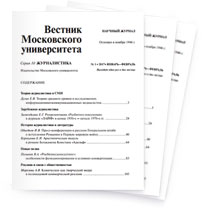Paralinguistic Means in the Information-Analytical Discourse: the Perceptive Aspect
Download paperDoctor of Philology, Professor at the Chair of Journalism and Integrated Communications, Vyatka State University, Kirov, Russia
e-mail: usr08728@vyatsu.ruMaster of Journalism, Correspondent of the News Service, TV 43 Region television company, Kirov, Russia
e-mail: vladimir_vakhrushev@bk.ruSection: Media Language
The article examines paralinguistic means of communication as components of non-verbal semiotics of information-analytical discourse. The authors describe the methodology of the applied research of the audience’s perception and assessment of the presenter’s non-verbal actions, which was carried out on the material of the video clips of the program "Results of the Week with Irada Zeynalova" on the NTV channel. The products of multiformat presentation of news – textual and audiovisual – are compared. The effectiveness of the use of non-verbal means of communication as a component of the polysemiotic code of discourse is determined by the fact that the recipient of the news message recognizes the validity and fairness of the broadcast point of view. The degree of dependence of the addressee's decision on the persuasiveness of the presenter’s position on the subjective-evaluative characteristics of the non-verbal in the television journalistic text is determined by a number of features relevant for the transmitted information. The high indicators of negative assessment of the non-verbal actions of the TV presenter revealed during the analysis of the recipients' communicative reactions are associated, as a rule, with external factors: increased emotionality, overexpression and unjustified motor activity in the process of transmitting information.
DOI: 10.30547/vestnik.journ.3.2021.102120References:
Allan S. (2010) News culture. Vol. 3. Maidenhead: Open University Press.
Annenkova I. V. (2012) Sovremennaya mediakartina mira: neoritoricheskaya model’ (lingvofilosofskiy aspekt): avtoref. dis. ... d-ra filol. nauk. [Modern Media Picture of the World: the Neo-Rhetorical Model (the Linguophilosophic Aspect): extended abstract of Dr. philol. sci. diss.] Moscow. (In Russian)
Bart R. (1994) Ritorika obraza [The Rhetoric of Image]. In Bart R. Izbrannye raboty: Semiotika. Poehtika [Selected Works: Semiotics. Poetics]. Moscow. (In Russian). Available at: http://www.philology.ru/literature1/barthes-94a.htm (accessed: 20.01.2021).
Barchas-Lichtensteina J., Voiklis J., Glasser D., Fraser J. (2021) Finding Relevance in the News: The Scale of Self-Reference. Journal of Pragmatics 171: 49–61. DOI: https://doi.org/10.1016/j.pragma.2020.10.001
Bednarek M., Caple H. (2012) News Discourse. London: Continuum.
Bednarek, M., Caple H. (2017) The Discourse of News Values: How News Organizations Create Newsworthiness. New York: Oxford University Press. DOI: 10.1093/acprof:oso/9780190653934.001.0001
Danesi M. (2010) Semiotics. Toronto. Pp. 475–480. Available at: https://www.sciencedirect.com/science/article/pii/B9780080448947015189 (accessed: 20.01.2021). DOI: https://doi.org/10.1016/B978-0-08-044894-7.01518-9
Eilders C. (2008) News as Discourse. DOI: https://doi.org/10.1002/9781405186407.wbiecn020
Feng D. (2016) Doing “Authentic” News: Voices, Forms, and Strategies in Presenting Television News. International Journal of Communication 10: 4239– 4257. Available at: https://ijoc.org/index.php/ijoc/article/view/4221 (accessed: 28.12.2020).
Fiske J. (1988) Television culture. London: Routledge.
Grigor’eva S. A. (2001) Slovar’ yazyka russkikh zhestov [Dictionary of Russian Sign Language]. Moscow: Yazyki russkoy kul’tury Publ.; Vena: Wiener Slawistiscer Almanach. (In Russian)
Klushina N. I. (2020) Mul’timedial’nyi kod yazyka i ego rol’ v politicheskoi lingvistike [Multimedia Language Code and Its Role in Political Linguistics]. Politicheskaya lingvistik 6 (84): 19–25. DOI: 10.26170/pl20-06-02 (In Russian)
Kochetkov P. (2013) Television News Discourse. In M. N. Volodina (ed.) Mediensprache und Medienkommunikation im interdisziplinaren und interkulturellen Vergleich [Media Language and Media Communication in an Interdisciplinary and Intercultural Comparison]. Mannheim: Institut fur Deutsche Sprache. Pp. 191–199.
Kreidlin G. E. (2004) Neverbal’naya semiotika [Nonverbal Semiotics]. Moscow: Novoe literaturnoe obozrenie Publ. (In Russian)
Labunskaya V. A. (1986) Neverbal’noe povedenie (sotsial’no-pertseptivnyi podkhod) [Nonverbal Behavior (a Social-Perceptual Approach)]. Rostov-on-Don: Rostov University Publ. (In Russian)
Mal’tseva I. A. (2017) Priemy psikhologicheskogo vozdeistviya SMI na teleauditoriyu posredstvom vypuskov novostei [Psychological Techniques of Mass Media Influence on the TV Audience Through News Releases]. Istoricheskaya i sotsial’no-obrazovatel’naya mysl’ 9 (6-1): 137–147. DOI: 10.17748/2075-9908-2017-9-6/1-137-147 (In Russian)
Piazza R., Haarman L. (2016) A Pragmatic Cognitive Model for the Interpretation of Verbal-Visual Communication in Television News Programmes. Visual Communication 15: 461-486. DOI: https://doi.org/10.1177/1470357215621688
Piz A. (2019) Novyi yazyk telodvizhenii [New Body Language]. Moscow: Eksmo Publ. (In Russian)
Pollard M., Kavanagh J. (2019) Profiles of News Consumption. Platform Choices, Perceptions of Reliability, and Partisanship. DOI: 10.7249/RR4212
Pounds G. (2012) Multimodal Expression of Authorial Affect in a British Television News Programme. Discourse, Context & Media 1 (2–3): 68–81. DOI: 10.1016/J.DCM.2012.03.001
Shemyakina E. V. (2014) Sotsial’nyi smysl zhesta: filosofskii analiz: dis. ... kand. filos. nauk. [Social Significance of a Gesture: Philosophical Analysis: PhD philos. sci. diss.] St. Petersburg. (In Russian)
Tarasova I. V., Minets D. V. (2016) Rechevoi portret sovremennogo televedushchego (po materialam programmy «Voskresnoye “Vremya” s Iradoi Zeinalovoi») [Speech Portrait of a Modern TV Presenter (based on the materials of the Program “Sunday “Time” with Irada Zeynalova”)]. Tavricheskii nauchnyi obozrevatel’ 7 (12): 99–104. (In Russian)
Tolson A. (2011) Political Discourse in TV News. Conversational Presentation and the Politics of ‘Trust’. In M. Ekström, M. Patrona (eds.) Talking Politics in Broadcast Media: Cross-Cultural Perspectives on Political Interviewing, Journalism and Accountability. Pp. 57–74. Available at: http://www.gbv.de/dms/sub-hamburg/661700593.pdf (accessed: 12.01.2021). DOI: 10.1075/DAPSAC.42
Volkova Yu. S., Salimovskii V. A. (2014) Informatsionno-analiticheskii teleehfir: novye formy neverbal’nogo povedeniya telezhurnalistov [News Broadcasting: New Forms of Journalists’ Nonverbal Behavior]. In V mire nauki i iskusstva: voprosy filologii, iskusstvovedeniya i kul’turologi [In the World of Science and Art: Issues of Philology, Art History and Cultural Studies]. Novosibirsk: SiBAK Publ. Pp. 148–154. (In Russian)
Zuev V. A. (2004) Neverbal’nye sredstva i ikh aspekty v deyatel’nosti zhurnalista: dis. ... kand. filol. nauk. [Nonverbal Means and Their Aspects in a Journalist’s Activity: PhD philol. sci. diss.] Krasnodar. (In Russian)






